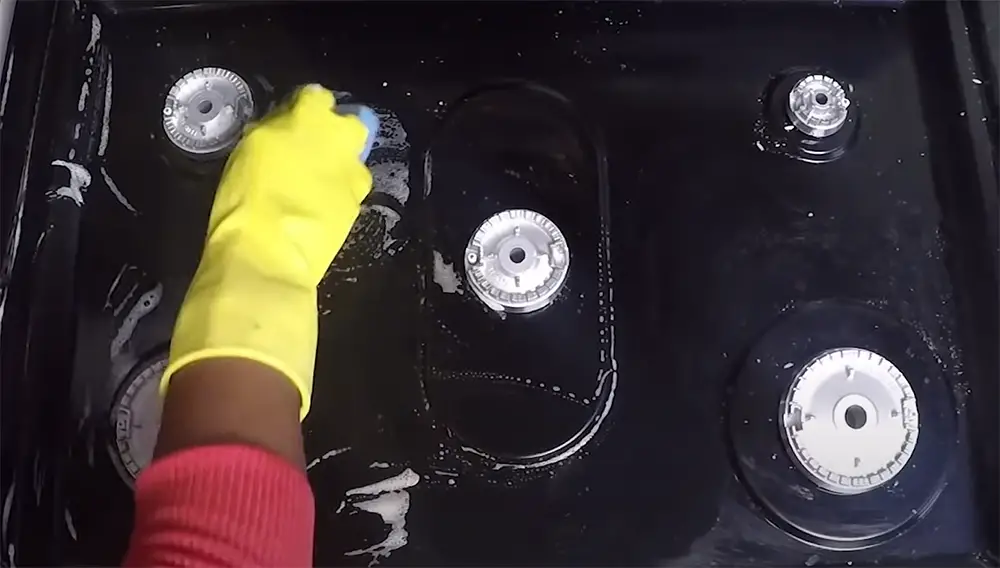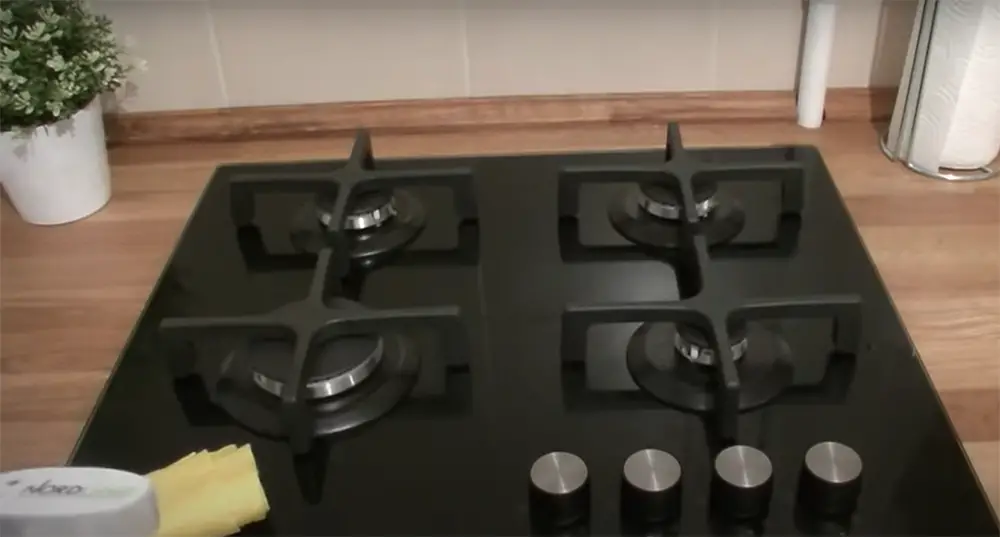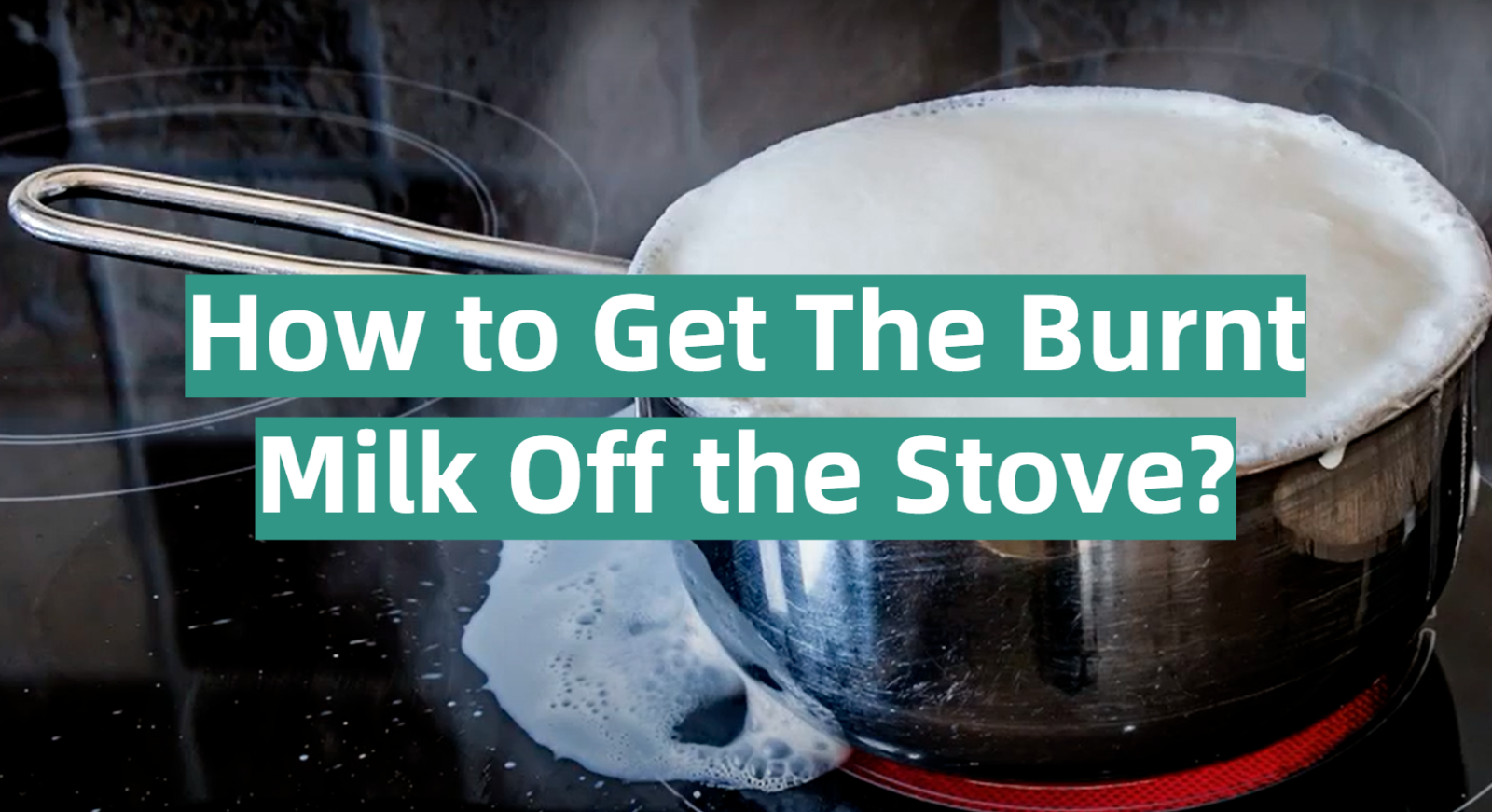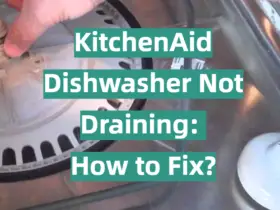It’s happened to the best of us. You’re cooking dinner, and suddenly you hear a loud sizzle followed by a splash. You turn around to see that your pan of milk has boiled over and is now covering your stove in burnt milk. Yuck! If this has ever happened to you, don’t worry! In this article, you will get to know the best way to remove scorched foods from your stovetop.
Does milk burn easily?
Yes, milk does burn easily and it can be very difficult to remove scorched milk from the stove. It happens because milk is mostly water and when it’s heated, the water starts to evaporate quickly. This causes the milk solids to become concentrated and they will eventually burn if the temperature is high enough.
At what temp does milk burn?
Milk can start to burn at a temperature of around 118 degrees Celsius. This means that it is important to keep a close eye on the milk while it is cooking, to prevent any from burning. You should cook milk dishes on a lower heat setting, and stir often to prevent scorching. It is easy to do if you follow some pieces of advice.

Tips To Get The Burnt Milk Off From The Stove
If you’ve ever dealt with the frustration of burnt milk on the stove, you know it can be a real pain to clean. But don’t worry, we’re here to help! With a little elbow grease and these tips, that burnt milk will be gone in no time.
1. By using baking soda
Baking soda is a great way to remove burnt milk from the stove. All you need to do is make a paste with baking soda and water, then apply it to the affected area. Let it sit for a few minutes before scrubbing with a sponge or brush. Rinse with clean water and voila! The burnt milk should be gone.
The baking soda works great because it’s a natural abrasive, which helps to scrub away the burnt milk and any residue. Its operating principle is also to neutralize the acidic scorched milk [2].
2. By using the razor blade method
If you don’t have any baking soda on hand, the razor blade method is a great alternative. Just wet the area where the burnt milk is and use a razor blade to scrape off the burnt milk. It might take a little bit of elbow grease, but it’ll get the job done.
Be careful when using this method, as you can easily cut yourself if you’re not careful. Make sure to use a sharp blade and be very careful when scraping off the burnt milk.
3. By using a cleaner with vinegar
If you want to use a cleaner that you already have on hand, vinegar is a great option. Simply mix equal parts vinegar and water and apply it to the affected area. Let it sit for a few minutes before scrubbing with a sponge or brush. Rinse with clean water and your stove should be as good as new!

4. Buffing and finishing
Once you’ve removed the burnt milk from the stove, it’s time to give it a good cleaning. Buff the area with a clean cloth and some all-purpose cleaner. Finish by wiping down the area with a damp cloth.
These procedures will help to remove any residue and give your stove a nice, clean finish. Moreover, it will also help to protect your stove from future burns.
5. Weiman’s cooktop max
If you want to give your stove an extra layer of protection, Weiman’s cooktop max is a great option. It’s a ceramic cookware cream that forms a protective barrier against burns and scratches.
Simply apply the cream to a clean, dry cloth and rub it on the surface of your stove. Let it dry for 24 hours before using your stove. This will give the cream time to form a durable, heat-resistant barrier.
Weiman’s cooktop max is a great way to protect your stove and keep it looking new. It’s easy to use and only requires one application per year.
Keep the following tips in mind
Use these tips when trying to remove burnt milk from your stovetop:
- Try using a scrub brush or steel wool to remove the burnt milk.
- If the milk is scorched onto the surface of your stove, you may need to use a cleaner or degreaser to get rid of it.
- Be sure to rinse off all of the cleaners before using your stove again.
Clean while cool
If you can, it’s best to wait until the stovetop is cool before beginning to clean it. This will make the task much easier and less time-consuming.

If you’re dealing with a recent spill, use a wet rag or paper towel to blot up as much of the milk as possible. Then, follow one of the methods below.
If the burnt milk has been on the stovetop for a while, it may be harder to remove. In this case, you’ll likely need to use a cleaner or degreaser. Be sure to read the directions carefully and follow all safety precautions before using any chemical cleaners.
Less is more
When using a cleaner or degreaser, it’s important to use the minimum amount necessary. This will help to avoid damaging your stovetop and making the problem worse.
Applying too much cleaner can also be dangerous, so be sure to follow the directions carefully.
If you’re not sure how to proceed, it’s always best to consult a professional. They’ll be able to assess the situation and give you specific instructions on how to clean your stovetop safely and effectively.
Consult your manufacturer’s instructions
When in doubt, always err on the side of caution and contact a professional for help. With these tips in mind, you should be able to clean your stovetop quickly and easily!
Use gentler tools
If the burnt milk is only on a small area of your stovetop, you may be able to use gentler tools to remove it. They are less likely to damage the surface of your stove.

Some people find that a scrub brush or steel wool is effective for removing burnt milk. Others prefer to use a putty knife or razor blade. If you choose the scrub brush or steel wool, be sure to use caution and avoid scratching the surface of your stove.
If you’re using a razor blade or putty knife, be especially careful not to damage the surrounding area and your hands. Handle these tools with care and only use them if necessary.
How to use the chemicals to clean the stovetop?
There are a few chemicals that can be used to clean the stovetop, but the best one to use is trisodium phosphate. This chemical will break down the burnt milk and make it easier to wipe away. You can find this chemical at most hardware stores.
To use this chemical, you will need to:
- Dilute the trisodium phosphate with water according to the package directions.
- Apply the diluted solution to the burnt area of the stovetop.
- Let it sit for a few minutes so that it can break down the burnt milk.
- Wipe away the solution with a clean cloth. Repeat if necessary.
You should always wear gloves when using this chemical because it can be irritating to the skin. If you get any of the solutions on your skin, you should immediately wash it off with soap and water.
Comparison of Methods for Removing Burnt Milk from the Stove
This table compares different methods for effectively removing burnt milk stains from the stove. The methods are evaluated based on key indicators such as effectiveness, ease of use, and cost. The table provides useful information to help you choose the most suitable method for cleaning burnt milk off your stove.
| Method | Effectiveness (scale: 1-5) | Ease of Use (scale: 1-5) | Cost (USD) |
|---|---|---|---|
| White Vinegar | 4 | 4 | $2.99 |
| Baking Soda Paste | 3 | 3 | $0.99 |
| Lemon Juice | 3 | 4 | $1.49 |
| Commercial Stove Cleaner | 5 | 3 | $5.99 |
| Ammonia Solution | 5 | 2 | $3.49 |
This table presents a comparison of different methods for removing burnt milk stains from a stove. The methods are evaluated based on three indicators: effectiveness, ease of use, and cost. Each method is assigned a rating on a scale of 1 to 5 for effectiveness and ease of use, with 1 being the lowest and 5 being the highest. The cost is provided in USD.
The methods included in the table are:
- White Vinegar: This method receives a rating of 4 for both effectiveness and ease of use. It is an affordable option at a cost of $2.99.
- Baking Soda Paste: This method receives a rating of 3 for both effectiveness and ease of use. It is the most cost-effective option at a low price of $0.99.
- Lemon Juice: This method receives a rating of 3 for effectiveness and 4 for ease of use. It is relatively affordable at a cost of $1.49.
- Commercial Stove Cleaner: This method receives the highest rating of 5 for effectiveness but a rating of 3 for ease of use. It is the most expensive option at $5.99.
- Ammonia Solution: This method also receives a rating of 5 for effectiveness but a rating of 2 for ease of use. It is moderately priced at $3.49.
Using this table, you can compare the different methods based on their effectiveness, ease of use, and cost to make an informed decision on the best method for removing burnt milk stains from your stove.
FAQ
How do you get burnt milk off a stovetop?
If you have scorched milk on your stovetop, the best way to remove it is with a baking soda paste. Make a thick paste out of baking soda and water, and apply it to the burnt area. Let the paste sit for a few minutes, then scrub it away with a wet sponge or cloth. The burnt milk will come off along with the baking soda.
How do I prevent my milk from scorching?
To prevent your milk from scorching, cook it over low heat and stir it frequently. Be sure not to let the pan get too hot, and don’t leave the milk unattended while cooking. If you see that the milk is starting to brown or burn, turn down the heat immediately.
How do you remove burnt milk?
To remove burnt milk, make a paste out of baking soda and water, and apply it to the burnt area. Let the paste sit for a few minutes, then scrub it away with a wet sponge or cloth. The burnt milk will come off along with the baking soda.
How do you get burnt on a pan off a ceramic stovetop?
If you have burnt milk or food on a ceramic stovetop, the best way to remove it is with a vinegar and water solution. Mix equal parts vinegar and water in a spray bottle, and spritz the burnt area. Let the solution sit for a few minutes, then scrub it away with a wet sponge or cloth. The burnt milk or food will come off along with the vinegar.
How do you get burnt food off a glass-top stove?
If you have burnt food on a glass-top stove, the best way to remove it is with a baking soda paste. Make a thick paste out of baking soda and water, and apply it to the burnt area. Let the paste sit for a few minutes, then scrub it away with a wet sponge or cloth. The burnt food will come off along with the baking soda.
Baking soda is an effective cleaning agent for many surfaces, including stovetops. If you have burnt milk or food on your stovetop, make a paste out of baking soda and water, and apply it to the affected area. Let the paste sit for a few minutes before scrubbing it away with a wet sponge or cloth. The milk or food will come off with baking soda.
Can you use a razor blade to clean a glass top stove?
You can use the special razor blade made for cleaning glass top stoves. First, make sure the stovetop is cool. Then, lightly glide the razor blade across the surface of the stove to remove any burnt food or milk. Be careful not to scratch the stovetop with the razor blade.
What are some effective methods to remove burnt milk from a stove?
There are several methods you can try to remove burnt milk from a stove:
- Vinegar and baking soda: Create a paste by mixing equal parts vinegar and baking soda. Apply the paste to the burnt milk stains and let it sit for a few minutes. Scrub the area gently with a sponge or cloth, then rinse with water.
- Lemon juice: Squeeze fresh lemon juice onto the burnt milk stains and let it sit for a few minutes. Scrub the area with a sponge or cloth, then rinse with water.
- Boiling water: Fill a pot with water and bring it to a boil. Carefully pour the boiling water onto the burnt milk stains on the stove. Allow the water to soften the burnt milk, then use a sponge or cloth to wipe it away.
- Dish soap and warm water: Mix a few drops of dish soap with warm water. Dip a sponge or cloth into the soapy water and gently scrub the burnt milk stains. Rinse with clean water.
Is it safe to use abrasive cleaners or scouring pads to remove burnt milk?
No, it is generally not recommended to use abrasive cleaners or scouring pads on stoves, especially if they have a delicate surface. Abrasive materials can scratch or damage the stove’s surface, making it more difficult to clean in the long run. It is best to use non-abrasive methods, such as the ones mentioned earlier, to remove burnt milk stains.
What should I do if the burnt milk is stubborn and won’t come off easily?
If the burnt milk stains are stubborn and won’t come off easily, you can try the following steps:
- Soaking: Fill a basin or sink with warm water and add a small amount of dish soap. Place the removable parts of the stove, such as burner grates or knobs, into the soapy water and let them soak for a few hours or overnight. This can help loosen the burnt milk and make it easier to remove.
- Use a non-scratch scrub brush: If the stove’s surface allows, you can use a non-scratch scrub brush or sponge to gently scrub the stubborn burnt milk stains. Be careful not to apply too much pressure or use abrasive materials that can damage the stove.
- Repeat the cleaning process: If the burnt milk stains persist, you may need to repeat the cleaning process multiple times, using one of the recommended methods, until the stains are completely removed.
- Seek professional help: If all else fails, and the burnt milk stains are still difficult to remove, it might be best to consult a professional stove cleaner who can assess the situation and provide expert advice on how to safely clean your specific stove model.
Can I use oven cleaner to remove burnt milk from the stove?
No, it is not recommended to use oven cleaner to remove burnt milk from a stove. Oven cleaners are typically designed for use on oven interiors and may contain harsh chemicals that can damage the stove’s surface. It is best to stick to non-abrasive and stove-safe cleaning methods, such as those mentioned earlier, to effectively and safely remove burnt milk stains.
Is it safe to use a razor blade or scraper to remove burnt milk from a stove?
No, it is not recommended to use a razor blade or scraper to remove burnt milk from a stove. These tools can easily scratch or damage the stove’s surface, especially if it is made of glass or ceramic. It is best to use non-abrasive methods and cleaning solutions specifically designed for stovetop cleaning to avoid causing any harm to the stove.
What should I do if the burnt milk has created a stubborn residue on the stove?
If the burnt milk has left behind a stubborn residue on the stove, you can try the following steps:
- Heat and vinegar method: Mix equal parts vinegar and water in a small pot. Heat the mixture on the stove until it begins to boil. Allow it to simmer for a few minutes, then turn off the heat and let it cool down. Use a sponge or cloth soaked in the vinegar solution to gently scrub the residue. Rinse with clean water.
- Baking soda paste: Make a paste by mixing baking soda with a small amount of water. Apply the paste to the residue and let it sit for about 15 minutes. Gently scrub the area with a sponge or cloth, then rinse with water.
- Commercial stove cleaner: If the residue is particularly stubborn, you can consider using a commercial stove cleaner that is safe for your stove’s surface. Follow the instructions provided by the manufacturer and use the cleaner as directed.
- Consult the stove’s manual: If you have the manual for your stove, refer to it for specific cleaning instructions and recommended products that are safe to use on your stove’s surface.
Can I use vinegar and water to prevent burnt milk stains on the stove?
Vinegar and water can be used as a preventive measure to minimize the chances of burnt milk stains on the stove. After cleaning your stove, you can mix equal parts white vinegar and water in a spray bottle. Spray the mixture onto the stove’s surface and wipe it clean with a soft cloth. Vinegar has natural cleaning properties that can help break down residue and prevent it from sticking to the stove’s surface.
Are there any tips to prevent milk from burning on the stove?
To prevent milk from burning on the stove, you can follow these tips:
- Use low to medium heat: When heating milk, start with low to medium heat to avoid scorching or boiling over. High heat can cause the milk to burn quickly.
- Stir continuously: While heating milk, stir it continuously with a whisk or spoon to distribute the heat evenly and prevent it from sticking to the bottom of the pot.
- Use a heavy-bottomed pot: A heavy-bottomed pot or saucepan can help distribute heat more evenly and reduce the chances of burning the milk.
- Remove from heat promptly: Once the milk reaches the desired temperature or starts to steam, remove it from the heat source immediately to prevent further heating and potential burning.
Useful Video: How to remove burn marks on stove top FAST | IT WORKS!!
Conclusion
If you’ve followed the steps above, you should now have a clean stovetop and no more burnt milk! If you’re still struggling to remove stubborn scorched foods, consider using a commercial cleaner designed for removing tough stains. With a little elbow grease, your stovetop will be good as new in no time.
References:
- https://answersdrive.com/what-temperature-does-milk-burn-at-2929182
- https://krostrade.com/blog/how-to-get-the-burnt-milk-off-the-stovetop/














I’ve found that the best way to get burnt milk off my stove is to let the area soak with hot soapy water for at least 10 minutes before scrubbing. The hot water helps loosen the burnt bits and makes them much easier to remove. Just be sure not to scratch your stove top!
One time I accidentally burnt a whole pot of milk onto my glass stove top. What a mess! I let it cool completely before using a plastic scraper to gently lift off the bigger chunks. Then for the remaining burnt-on milk, I made a paste of baking soda and water and let it sit for about 30 minutes before scrubbing it all away. Worked like a charm.
I recently tried using lemon juice to clean burnt milk from my electric stove top and was amazed at how well it worked. Just squeeze some lemon juice onto the burnt areas, let it sit for a few minutes, then wipe clean with a soft cloth. The citric acid in the lemon juice breaks down the burnt milk protein fast. So much easier than scrubbing!
After burning milk on my stove top yet again, I decided to try something different – a pumice stone! I just gently rubbed the stone over the burnt spots in a circular motion while the area was still warm. It scrubbed off all the burnt milk with minimal effort and didn’t scratch the surface at all. I’ll definitely be using this trick from now on.
I was in despair over some burnt milk that had turned into what seemed like an immovable black crust on my stove top. Out of desperation, I grabbed a plastic putty knife and carefully scraped away, trying not to scratch the surface. It took some time and elbow grease, but the crust eventually came up. Next time I’ll remember to address spills quickly before they turn into burnt messes!
One time I boiled over a whole pot of milk on my electric stove. I tried scrubbing but that burnt milk would not budge! Finally I mixed up a paste of baking soda and dish soap, spread it on liberally, and let it work for an hour. Came back and all the scorched milk wiped right off. Baking soda is amazing for cleaning burnt on messes!
I recently burnt milk badly on my glass top stove and thought I’d never get it off. Out of ideas, I used a razor blade scraper. I was very gentle and cautious not to scratch the glass, applying light pressure and going slowly. It worked remarkably well to scrape off all the burnt bits. Just be very careful if attempting this method!
While making hot cocoa, I once let the milk boil over and scorch onto my stove top. What a smelly sticky mess! I let it cool then went at it with paper towels and a plastic spatula, slowly chipping away at the burnt milk. It took a while but eventually my stove top was clean again. Now I watch pots more carefully so I don’t have to deal with burnt milk stench!
I tried everything to remove burnt on milk from my stove top – scrubbing, scraping, hot water, cleaners. Nothing worked completely. Finally on a whim I tried WD40. I sprayed it on the burnt spots, let it sit for a couple minutes, then wiped with a paper towel. To my surprise, it dissolved all the crusted milk! WD40 is now my go-to for cleaning scorched spills.
After boiling milk over on my stove, it left some stubborn burnt spots that regular cleaning methods just weren’t touching. In desperation, I used a single edge razor blade to gently scrape the burnt areas off. It actually worked remarkably well, removing all the crusty milk. Just be very cautious not to press too hard and scratch the surface when using a razor blade!
I accidentally burnt milk to the bottom of a pan that then crusted onto my glass top stove when I put the hot pan down. I tried scrubbing but it barely made a dent in the burnt milk. Finally I sprayed some oven cleaner on, let it sit for about 5 minutes, then wiped away the gunk with paper towels. It cleaned the stove top beautifully without any damage!
Once when boiling milk for hot chocolate, I got distracted and it bubbled over all over my electric stove top. After letting the stove cool down, I went at it with a plastic spatula to scrape off the larger chunks. Then for the remaining burnt-on spots, I used a scrubby sponge and warm soapy water, scrubbing gently in circles. With a little elbow grease the burnt milk came right off, thankfully!